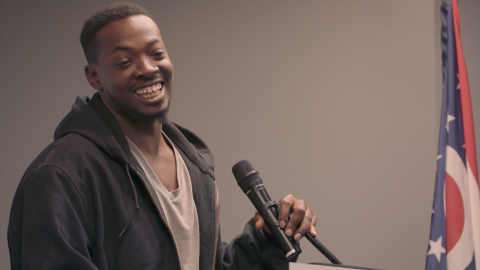Chris Dible, 17, walks past a giant red and black tractor. It鈥檚 the tractor Dible helped his dad bargain for when he was 13. Standing here, he can鈥檛 help but think about his family.
鈥淚 just you know, I see it and it鈥檚 like we鈥檝e worked for this,鈥� Dible says. 鈥淢y grandpa worked very hard, worked his whole life for it. This is the fruits of our labor, it needs to stay in the family as long as it can because we worked very hard for it and we worked very hard to maintain it.鈥�
Dible is a fourth-generation farmer on Dible Brothers鈥� Farm near Sunbury, Ohio. He鈥檚 not sure he鈥檒l be a farmer in the future, but he is dedicated to staying in the industry he loves.
There鈥檚 a lot of opportunity in this growing field. Agriculture is Ohio鈥檚 top industry, with over 540,000 jobs in this state. But it鈥檚 also facing a skills gap, with 20,000 open jobs and no one to fill them.
Positions in agriculture range from veterinarians, earning , to farm equipment mechanics, .
Jeanne Gogolski is the lead researcher for , an educational resource connecting students to careers in the agriculture industry. She says that agriculture is a bigger business than many think.
鈥淪o it's a, you know, $1 billion business here in the state of Ohio,鈥� Gogolski says. 鈥淎nd when you start thinking about jobs, I don't think people fully understand that when you say agriculture you're not talking about being a farmer necessarily.鈥�

Gogolski urges teachers throughout the state to incorporate agriculture in their everyday teaching of science, technology, engineering, and math 鈥� or STEM.
The idea that agriculture is more than just farming is also preached by Jeffrey Stimmell. He teaches Agriculture Science and works as part of a partnership with and the .
Stimmell is one of Chris Dible鈥檚 instructors and offers classes ranging from Agriculture Business to Food Science. He says agriculture has always incorporated important STEM lessons.
鈥淪o I think that Ag was STEM before STEM was STEM. That鈥檚 kind of one of the things I always like to talk about,鈥� Stimmell says. 鈥淪o if you think about science, technology, engineering, math, like students are doing all four of those things.鈥�
Stimmell not only introduces students to the industry, he also engages students who grew up understanding farming, food sciences, or other aspects of agriculture. Dible struggled in science class, until Stimmell connected the lessons directly to what he observed, which Dible says was a game-changer.
鈥淢y most favorite subject is of course Stimmell鈥檚 classes, but really the sciences,鈥� Dible says. 鈥淚t just relates to what I do and really I just get so much out of it and it鈥檚 so hands on.鈥�

Excelling in the classroom is plowing the way for Dible鈥檚 success in a farm-related industry 鈥� even if his family sells the farm. He is looking into certificate programs with John Deere or Case tractors after graduating from Big Walnut High School. Both are two-year programs that teach him how to become a service technician.
Dible welcomes the idea of forgoing a four-year degree.
鈥淚鈥檓 probably not gonna go to a four year university,鈥� Dible says. 鈥淕ood for me. You know, I can get the certifications I need from in two years. Why spend extra cash to go for two extra years 鈥� it will just be wasted money.鈥�
The average annual wage for a service technician is over $42,000 a year, and these jobs aren鈥檛 going anywhere. A spokesman from John Deere says that technician roles are vital to the company鈥檚 success and only increasing across the country. John Deere estimates local dealers will need to add about 4,000 technicians over the next five years.

Dible is the perfect candidate, and says he couldn鈥檛 see himself doing anything else.
鈥淵eah, it鈥檚 hard work, but also this is much better than sitting in a cubicle all day or whatever else, you know, an office job,鈥� he says. 鈥淚鈥檇 much rather be out here in nature, doing what I love鈥�
Agriculture jobs are open in manufacturing, engineering, sales, food science, animal genetics, and that鈥檚 just to name a few.
Corn and soy aren鈥檛 the only things growing out here in farm country.
This story comes from the , which is part of .






